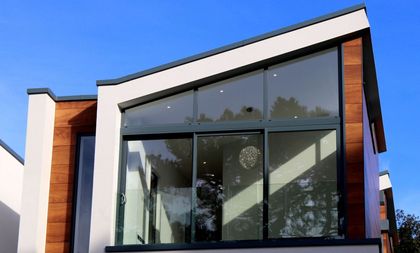Residential Window Tint: Maintain Your Home Cool in the Summer Season Heat
Residential Window Tint: Maintain Your Home Cool in the Summer Season Heat
Blog Article
Just How Residential Window Tinting Boosts Your Home's Energy Performance
Residential home window tinting offers a compelling service for home owners looking for to enhance energy effectiveness within their living areas. By using specialized films to home windows, it properly reduces heat transfer, thus supporting indoor temperature levels and minimizing the need for excessive heating or air conditioning.
Comprehending Home Window Tinting
Comprehending home window tinting is crucial for homeowners looking for to boost both convenience and power performance in their living rooms. Residential Window Tint. Home window tinting includes the application of a thin film to the interior or exterior surface area of glass home windows. This film can substantially regulate the amount of sunlight and heat that enters a home, thus affecting interior environment conditions
There are various kinds of window tinting movies readily available, each with distinctive residential properties. The efficiency of window tinting is usually determined by its Visible Light Transmission (VLT) portion, which indicates just how much light can pass with the movie.
Benefits of Power Effectiveness
Home window tinting not only boosts aesthetics yet also plays a substantial role in boosting energy effectiveness within domestic rooms. By decreasing warmth transfer through home windows, colored films develop a more steady interior climate, which can lead to considerable decreases in power usage for heating & cooling. This power effectiveness converts into lower energy costs, offering home owners with substantial long-lasting financial savings.

Furthermore, window tinting boosts the comfort of living spaces. By decreasing glow and blocking unsafe UV rays, colored windows develop a more positive atmosphere, which can result in boosted wellness for occupants. The defense against UV rays additionally assists preserve furnishings and flooring from fading, adding to the longevity of house products.
How Tinting Works
Tinting films run with a mix of innovative materials and modern technologies made to regulate the amount of solar power entering a home. Largely composed of polyester, these movies frequently include metallic or ceramic fragments that absorb and show warmth. This dual capacity permits them to considerably lower the penetration of ultraviolet (UV) rays and infrared radiation while allowing noticeable light to pass through.
The efficiency of home window tinting is measured by its solar heat gain coefficient (SHGC), which suggests just how much solar energy is transferred via the home window. Lower SHGC values are better as they denote greater warm being rejected. In addition, window tints can feature a range of tones, permitting homeowners to personalize their aesthetic choices while boosting power performance.
Furthermore, these films serve as an obstacle, stopping warmth loss go to my blog throughout cooler months by mirroring indoor warmth back into the home. This thermal insulation effect complements the cooling benefits acquired during warmer months, adding to a balanced indoor climate year-round. By managing solar power efficiently, property window tinting not only enhances comfort but also plays a vital role in reducing power intake and decreasing energy bills.
Picking the Right Color

There are different kinds of window films readily available, including dyed, metalized, and ceramic. Ceramic movies give exceptional heat control without endangering exposure and are highly durable, making them a preferred option.
Visible light transmission (VLT) is another you could look here essential variable, as it indicates the amount of all-natural light that can pass through the tinted glass. House owners ought to choose a tint with a VLT that matches their lights preferences while still providing sufficient glare reduction.
In addition, evaluating the solar warmth gain coefficient (SHGC) can assist establish just how well a color can block warmth from sunshine. A lower SHGC indicates better heat control, inevitably boosting power effectiveness.
Setup and Maintenance Tips
Correct setup and maintenance are essential elements in optimizing the benefits of residential home window tinting. To achieve optimum results, it is this page advisable to work with a qualified specialist for setup. This ensures that the color is applied properly, avoiding air bubbles, creases, or misalignment that might compromise efficiency. Professionals likewise make use of specialized tools and strategies, which can enhance the longevity and efficiency of the color.
Complying with setup, maintenance is vital to lengthen the life of the home window film. It is recommended to wait at least 30 days prior to cleaning up the tinted home windows to allow the glue to cure fully.
Attending to these concerns quickly can avoid additional damage and keep power performance. By sticking to these setup and maintenance pointers, home owners can guarantee their window tinting proceeds to offer substantial power cost savings and comfort for years to come.
Final Thought
To conclude, residential home window tinting works as an effective option for boosting energy performance within homes. By decreasing heat transfer and blocking dangerous UV rays, home window movies add to reduce power usage and improved interior comfort. The choice of proper tinting products, together with appropriate installation and upkeep, further takes full advantage of these advantages. Eventually, window tinting represents a lasting financial investment that not just lowers utility bills however also advertises a comfortable living atmosphere throughout the year.
Window tinting involves the application of a slim film to the interior or exterior surface area of glass windows. By reducing warm transfer via windows, colored films create a more secure interior environment, which can lead to considerable reductions in energy usage for heating and cooling.The performance of home window tinting is determined by its solar warmth gain coefficient (SHGC), which suggests exactly how much solar power is transferred through the window. By handling solar energy properly, property home window tinting not just improves convenience but also plays an essential function in decreasing energy consumption and reducing energy expenses.
By minimizing warm transfer and obstructing hazardous UV rays, window films add to reduce power usage and boosted interior convenience.
Report this page